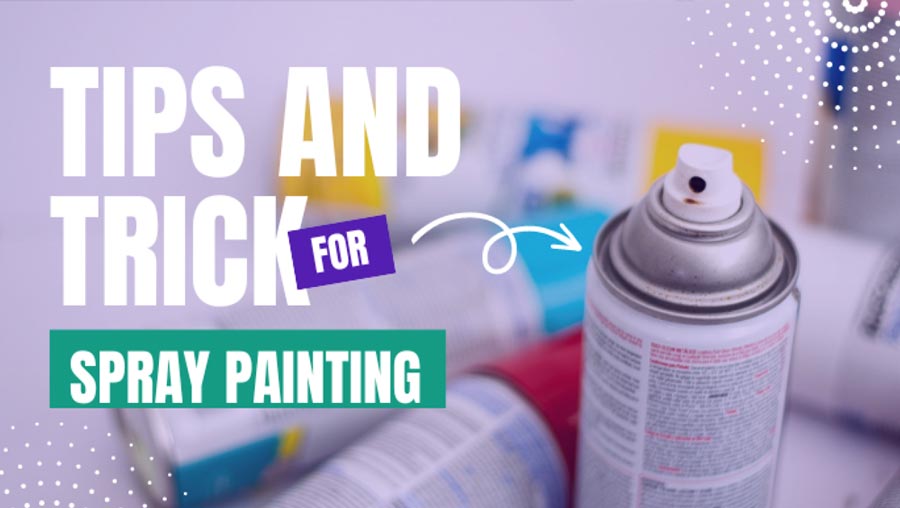Month: February 2023
Spray Painting Tips: Essential Do’s and Don’ts
Spray painting can be a great way to customise and transform your home or furniture. However, if it isn’t done correctly, it can lead to a mess and even damage the material you are painting. Let us see the best tips for spray painting to help you achieve a professional-looking finish. We explain both do’s and don’ts that you should remember when spray painting to obtain a successful outcome.
Do: Prepare Surface
The first step to achieving success with spray painting is preparing the surface. From small projects like picture frames to more oversized items like furniture, all surfaces must be clean and free from dirt, grease, or residue before painting. Aerosol paint can spread and seep through every opening, so you can lay down a plastic layer and then place a canvas-covered frame over the area you are working on. It will ensure that no paint gets on surfaces that should not be painted.
Additionally, use painter’s tape along the designated borders to avoid accidental spills or overspray. Lay down newspapers or drop cloths to protect any furniture or other items near the job site. You also must wear protective clothing such as long sleeves and eye protection when spray painting, as aerosol particles may enter the eyes or lungs if not appropriately protected.
Do: Wear Protective Gear
Spray painting is an easy and fun activity that can be done to spruce up objects around the house, from furniture to DIY projects. However, taking safety precautions before you begin spray painting is essential. Wearing gloves and a mask or goggles is necessary when using any paint aerosol. If you are working indoors, open the windows for proper ventilation. These simple steps will ensure your spray painting experience goes smoothly and safely.
Do: Use Thin Coats
Using thin coats will help you achieve even coverage over the entire surface without having unsightly runs or drips that can ruin the look of your project. To apply a thin coat, hold your can at least six inches away from whatever surface you’re spraying, and make sure that you overlap each pass slightly as you move along. It ensures an even spread of paint across the entire area, so there are no missed spots or heavy globs that could damage what you’re trying to create.
Do: Spray out the edges.
When performing a spray painting job, you should hold the can upright 6-10 inches from the surface and spray in a back-and-forth motion. Doing this will help ensure an even coat of paint, and it will also help prevent “jamming” or “stuck” issues. Additionally, you should start spraying off the edge of the surface and move inward towards the middle for more excellent coverage. Lastly, keep your arms moving when spraying so that you don’t end up with too much paint in one place.
Do: Shake the can
One of the essential steps in spray painting is to shake the can for at least two minutes before beginning your project. To ensure you have shaken enough, it helps to set a timer and keep shaking until it goes off. Your arm may get tired during this step, but you mustn’t give up too soon! When the paint is mixed correctly, it will come out more evenly, making it a better-looking finish. For best results, shake the can vigorously until all the contents are combined, and no lumps remain.
Don’t: Paint outside on hot days.
Spray paint will wear off or evaporate faster when the temperature is too high and can affect the quality of your work. So, if you’re determined to paint outdoors, proceed with caution on scorching days. The ideal outdoor temperature should range between 50 F and 90 F for the spray paint to stick correctly and last longer.
Don’t: Skip primer.
Primer is an adhesive that ensures the paint adheres to surfaces properly and avoids chipping or peeling off. It also helps fill any cracks or imperfections on the surface you’ll be painting, resulting in a smoother finish. If you don’t prime your surface before applying paint, your job will look sloppy and uneven. At worst, it won’t hold up very long and will quickly peel off. Make sure to select primers specifically designed for the material you’re working with; wood needs a different kind of primer from metal or plastic. Furthermore, applying multiple coats of primer can help ensure a more even coating.
Don’t: Spray too close.
You may be tempted to get close up when starting a spray painting project, but distance is your friend; if you start at a greater distance than necessary, you can always move closer as needed. With some practice, getting the perfect amount of paint on your project can easily be achieved by understanding how far away from the surface you should hold your can of paint while spraying.
The size and shape of the object also play an essential role in deciding how far away you should hold your spray paint from it; larger objects require more space between them and the nozzle than smaller ones do. To ensure you’re starting with the best distance, test on a piece of paper or cardboard to see how much product comes out. Always start 10 inches away, then decide if you want to spray closer.
Don’t: Ignore Drying Times
For paint to look flawless, each coat needs time to dry before you move on to the next. Waiting at least 20 minutes between coats is a must, although drying times can range from one to four hours, depending on the type and brand of spray paint used. Even though it may be tempting, never touch or feel the wet paint, as you risk smearing and ruining your work. It could also leave fingerprints on the dried paint, significantly lessening your project’s overall appearance.
Don’t: Overload the Paint
It is vital to pay close attention when using a spray gun for any project. When beginning your project, ensure not to overfill the gun with too much paint, as this will result in an uneven coating and splatter marks on your surface. Additionally, if you have already overloaded the surface with excess paint, do not add more – instead, take a step back and allow time to dry before adding additional coats if needed.
In conclusion, spray painting is a great way to give any piece of furniture or decor an instant upgrade. With the proper preparation, primer, and paint, you can be sure your project will look professional and last for years. Always practice on scrap wood before tackling a larger project. Spray painting can be a fun and rewarding experience if all precautions are taken into account.
Where to get the best spray paint?We, Creative Resins, offer premium quality spray paint at the best prices. We manufacture specialist paint for doors, glass, PVCu, and metal. We work with door, window, conservatory, and kitchen companies to offer materials, equipment, application systems, and specialized software to fulfill their decorative needs. Call us now! 01795 411820



